Social Media Marketing Strategies for Brands
When you discover a brand that you love, you want to share it with your friends and family, right? Food, coffee, makeup, cleaning products… it doesn’t matter. If it’s a great product, you want to share it.
People trust and value their friends’ opinions, but naturally they’re going to search for the brand’s website and social platforms, too. They want to see if the brand aligns with their lifestyle, ethics, and needs. If the brand checks all of their boxes, ultimately they’ll make a purchase, and hopefully become a repeat customer.
For today’s brands, having a social media presence is no longer a want, but a need. More importantly, having a strong social media marketing strategy is a must. Gone are the days of posting whatever you feel like. Today’s brands need to post strategically and with intention.
Whether you’re launching a new brand, or rebranding an existing one, grab an iced coffee and get ready to take notes. We’re explaining why is social media important for business, sharing types of social media social media marketing, and breaking down how to implement social media marketing strategies.
Let’s get started with our social media marketing introduction. What Is Social Media Marketing?
Social media marketing is a form of digital marketing that leverages social media platforms (e.g., Facebook, Instagram, LinkedIn, TikTok, etc.) to achieve specific brand goals. For businesses, these goals can include boosting brand awareness, driving traffic to the company’s website, and converting online visitors into customers.
Why Is Social Media Marketing Important for Business
With streaming services at an all-time high, brands can no longer rely on only television commercials, radio ads, or newspapers to target their audience. In today’s cord-cutting society, 55% of consumers learn about new brands on social media. If you don’t already have a social media presence, you’re missing an integral component of your digital marketing strategy.
Companies are using social media marketing to advertise new products/services and features, promote special offers, and connect with their customers. Connecting with customers is key, with 68% of consumers agreeing that social media enables them to interact with brands and companies. When a brand engages with a customer on social media, there is the potential to positively influence a customer’s decision to buy from that brand.
Advantages and Disadvantages of Social Media Marketing
Social media marketing sounds great, but what’s the catch? Full disclosure: there are advantages and disadvantages of social media marketing. But, the positives far outweigh the negatives, which we’ll get to in a minute.
Let’s touch on the advantages first.
Advantages of Social Media Marketing
When you have a strong social media marketing strategy in place, you’re sowing the seeds to reap future rewards. Here are four benefits of social media marketing:
-
Increases Brand Awareness. The right social media marketing can help you increase your brand visibility and recognition with your target audience. By sharing valuable, quality content you can answer questions and comment on trending topics to build trust and credibility with your audience.
-
Offers Targeted Advertising. Social media platforms allow you to really drill down to specific demographics, interests, and behaviors when creating targeted advertising campaigns. The more targeted you are, the increased chances of building your audience, which increases your leads and conversions, and hopefully sales.
-
Provides Measurable Results. Social media platforms like Facebook, LinkedIn, and X (formerly Twitter) offer analytics that provide brands with detailed insights into the performance of their social media marketing campaigns and audience behavior. These measurable results can be analyzed and used to improve existing and future advertising campaigns.
-
It’s Cost Effective. When done right, social media marketing is cost effective. Think about it: there’s no fee to create a social media account. Plus, you can use social platforms for both organic social media advertising and targeted paid social media advertising, making it more cost-effective than traditional marketing.
Disadvantages of Social Media Marketing
The benefits of social media marketing by far outweigh the negatives. However, it’s still important to be aware of the disadvantages so you can address them accordingly.
Here are four disadvantages of social media marketing:
-
Social Media Is Time-Consuming. It takes time, budget, and employee resources to build and maintain a social media presence. If you’re a startup, or a business with a lean budget and team, be sure you don’t bite off more than you can chew. If you can only allocate a small budget and a small team (right now) that’s okay. Remember it’s better to have quality content over quantity. You can always expand down the road when budget and staffing permit.
-
It Opens the Door for Negative Feedback. Giving customers a platform to share their thoughts opens the door for both positive and negative feedback. Constructive criticism can help you grow, but if you don’t handle negative feedback the right way, it can derail your reputation.
-
It’s Easily Affected by Algorithm Changes. One day your organic ads are flourishing, the next day they’re nowhere to be found. Welcome to the fickle world of social media algorithms. Any time there is a change to a social media platform’s algorithm, your social media posts will be affected.
-
Slow Return on Investment (ROI). Unlike paid advertising, organic advertising takes time to grow before you’ll see a significant positive return on investment (ROI).
Now that we’ve discussed what social media marketing is and its advantages and disadvantages, let’s go over who is responsible for implementing the social media marketing strategy.
Why You Need a Social Media Marketer
Having the right team in place to handle your social media marketing is key. After all, you wouldn’t have a doctor rebuild an engine, or a mechanic operate on a patient, right? For social media marketing, you need a social media manager and social media marketer.
What Is the Role of a Social Media Manager
A social media manager is in charge of the company’s social media program. They help develop strategies that align with their company’s values and goals, post content and engage with users, analyze and report results, and track trends.
Social media managers wear many hats. It isn’t uncommon for a social media manager to also fill the roles of community manager, content marketer, and even entrepreneur (especially if they’re the face of the brand).
What Is the Role of a Social Media Marketer
A social media marketer is responsible for executing the social media marketing. They use social media platforms to promote a brand, reach new customers, engage with current ones, and announce new products/services. They are the one who oversees the company’s social media strategy to make sure it’s being implemented and monitor social media analytics to optimize campaigns.
As you can see, there is some overlap in the duties for both the social media manager and social media marketer. When hiring for those roles, be crystal clear in the expectations so that your social media marketing (and management) runs smoothly.
Once your team is in place, it’s time for the fun part: brainstorming and implementing social media marketing ideas.
4 Social Media Marketing Ideas
So, how does a brand use social media to generate new business, promote a product/service/skill, or use employee advocacy to help with their visibility on social media?
We’re breaking it down for you with four real world social media marketing examples from notable brands. Let them be a source of inspiration for your own social media marketing ideas.
1. Ninja Kitchen
If you’re searching for how to promote a product on social media examples, look no further than Ninja Kitchen.
Ninja Kitchen’s YouTube Channel is a great resource for getting to know their products and how they work. Their homepage is well-organized, making it easy to find the product you’re looking for (e.g., oven, pressure cooker, air fryer, etc.). Their video content is engaging and concise, which is great for short attention spans. They also provide a brief description of the product below the video, too.

Source: Ninja Kitchen
Even better, they respond to customer inquiries in the comments section.
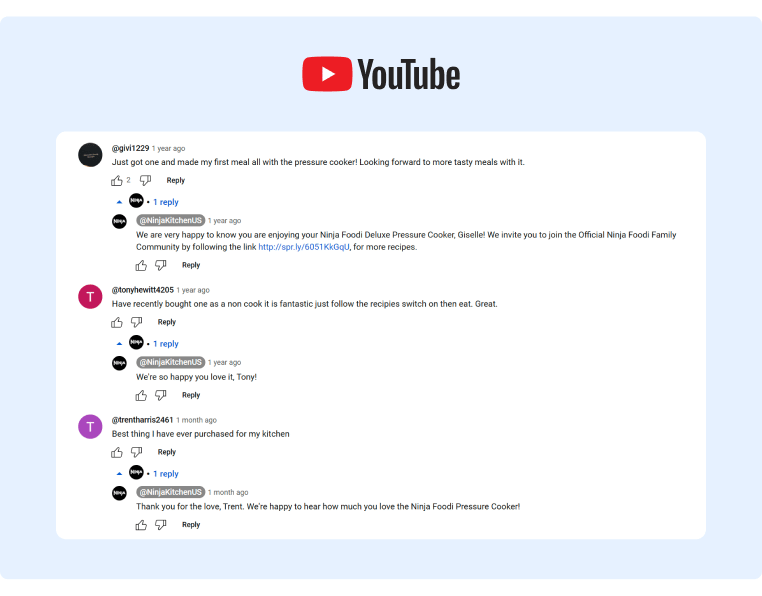
Source: Ninja Kitchen
Ninja Kitchen is a brand that creates quality products and content, makes it easy to share your favorite products with others on social media, and provides answers to your questions. If you’re looking for inspiration for promoting your product on a platform like YouTube, consider taking a page from Ninja Kitchen’s social media strategy playbook.
2. Michael’s
A store that sells crafts will have plenty of creative social media posts examples, and Michael’s doesn’t disappoint. On their Instagram page, you’ll find eye-catching images, how-tos, contests, and reels. Reels, in particular, are a great social media marketing tool.
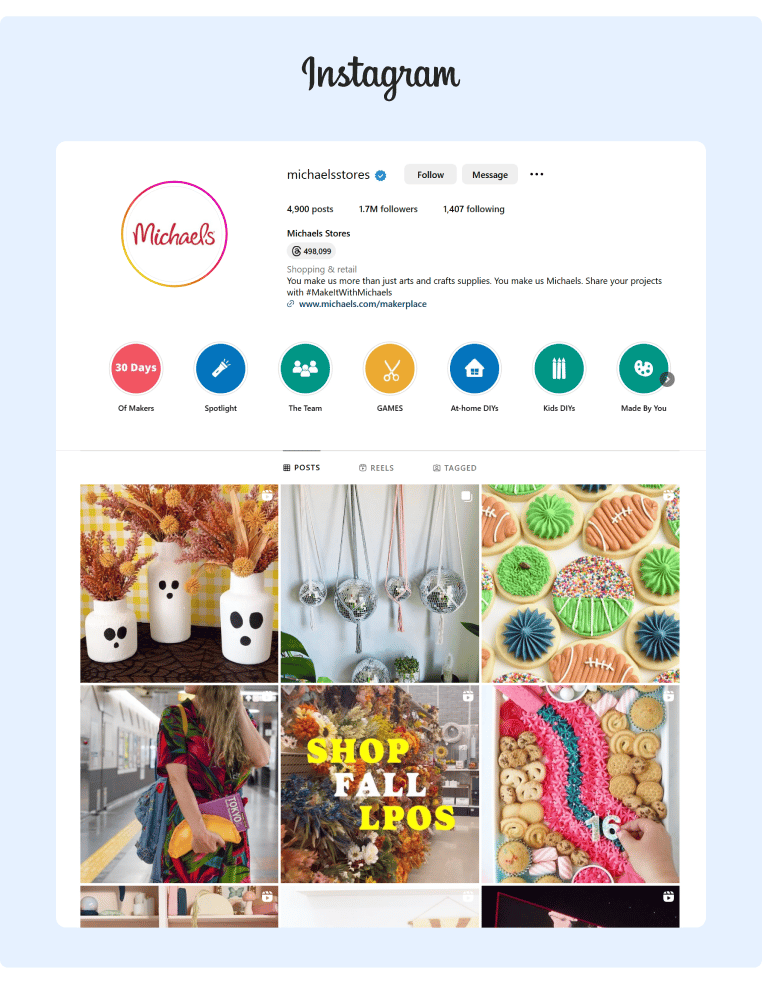
Source: Michael’s
Here, Michael’s collaborates with the Jonas Brothers to create a tongue-in-cheek reel about musician Kevin Jonas’ new obsession: “friendship bracelets.” With a dash of humor and some flashy beads, Michael’s achieves targeting not one, but two audiences – bead lovers and Jonas Brothers fans.
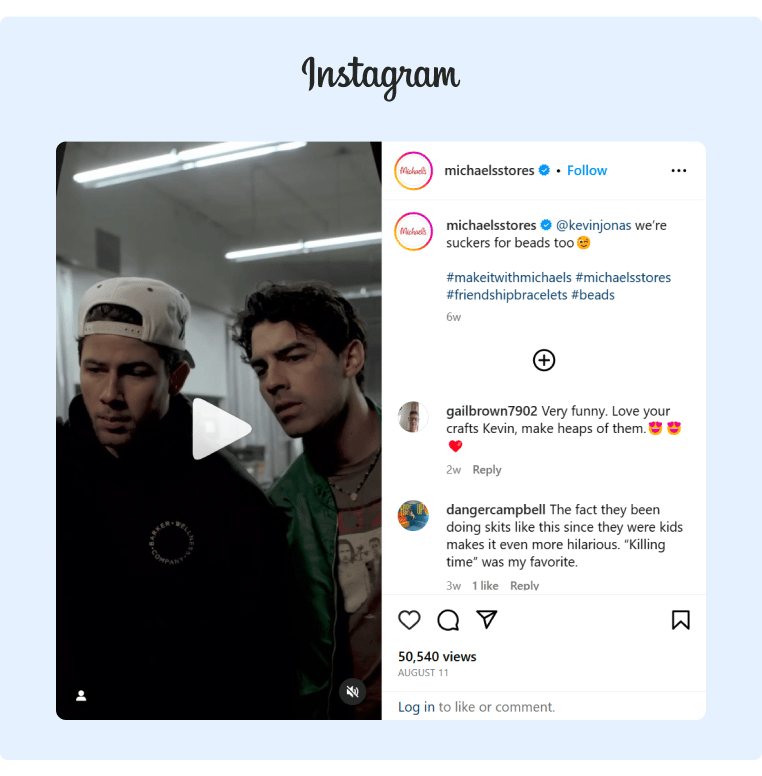
Source: Michael’s
Michael’s is also adept at capitalizing on trends like the Barbie movie which was a blockbuster summer hit, spurring themed parties for children and adults. And where did Barbie fans go to get their dream house decorating gear? Michael’s!
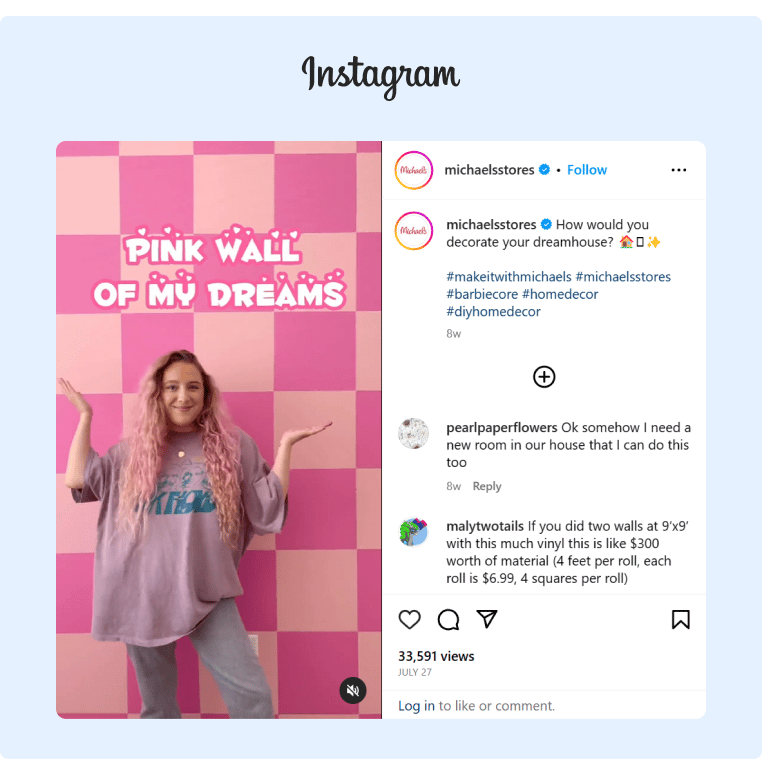
Source: Michael’s
If your brand is whimsical, colorful, and interactive, consider emulating some of Michael’s social media content ideas.
3. Starbucks
Starbucks social media marketing strategy is as strong as their coffee game. The brand is on a variety of social media platforms. It also utilizes all types of social media marketing: content marketing, advertising, influencer, user generated content, and paid media.
In this Instagram post example, check out their collaboration with Domonique, a digital creator. Starbucks coffee in hand, Domonique heads out to host her DC run club and shares her morning routine with us.
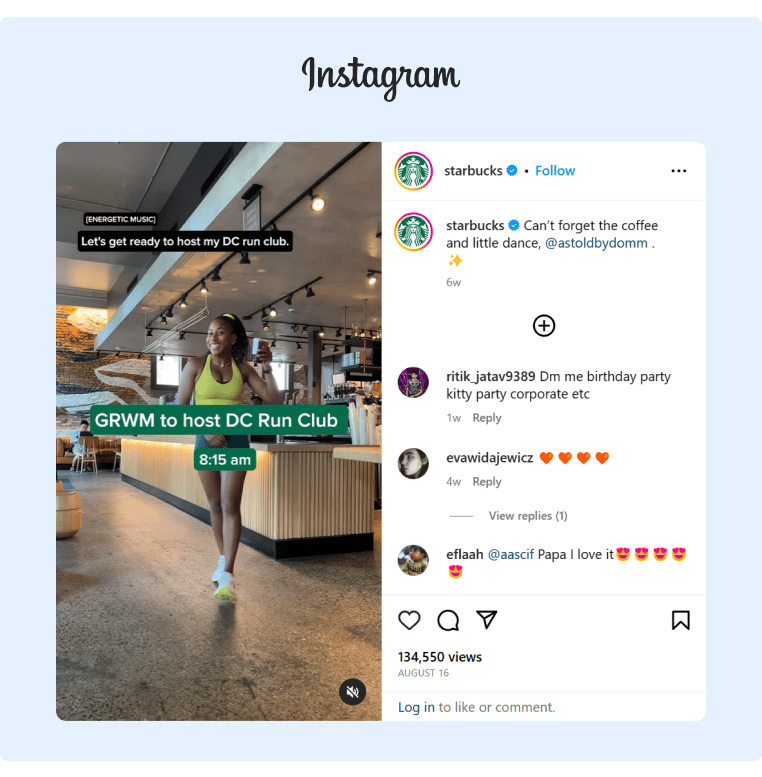
Source: Starbucks
Starbucks’ unique mixture of branded and user generated content appeals to all demographics of their audience, plus they make it easy to share content, broadening their audience reach.
4. TOMS
TOMS is a sustainable footwear brand that gives back. For their brand, occasionally sharing longform content as social media marketing articles is a great way to spread the word about their global initiatives.
Here, on their LinkedIn business page, they share a post about Mental Health Awareness Month and include a link where you can learn more.

Source: TOMS
This example is also a great opportunity for the brand to share social media content through employee advocacy. Pre written social media posts not only make it easy for employees to share company content, but also for social media marketers to control the messaging, too.
Employee advocacy is one of our top social media strategies which we’ll dive into in the next section.
Why Every Brand Needs a Social Media Strategy
What do Ninja Kitchen, Michael’s, Starbucks, and TOMS have in common? A robust social media strategy. Creating content with intention and strategically sharing it with the right audience is what separates these top brands from the rest in their respective markets.
Think of a social media strategy as your master plan for how you will use social media to promote your business. Your strategy needs to include:
- Content Plan and Guidelines: What content to post, how often to post, when to engage with your content, etc. (We highly recommend our social media marketing templates to help you stay organized.)
- Team Responsibilities: What your social media team will be responsible for (e.g., posting and engaging with content, optimizing and maintaining social profiles, etc.).
- Organic and Paid Social Media Advertising: In addition to organic advertising, you still want to use paid social media advertising to have your business appear in front of targeted users. Your ROI on paid social will be quicker since organic takes time to build.
- Measurable Goals: Determine what your goals are so you can track them. Goals can be building brand awareness, boosting leads, and increasing sales, etc.
You also need to implement a marketing strategy. Depending on your brand’s goals and target audience, one (or more) of the following four strategies will help you take your social media marketing to the next level.
1. Employee Advocacy
An employee advocacy strategy is a content promotion technique using your best resource: your employees. How it works: employees engage and share branded messages with their professional networks to reach more customers as a social selling tool and to increase brand awareness.
Employee advocacy is a great way to share company news, promote new products and services, and to recruit new talent. In this example, an employee is sharing a hiring post from their employer Sodexo.
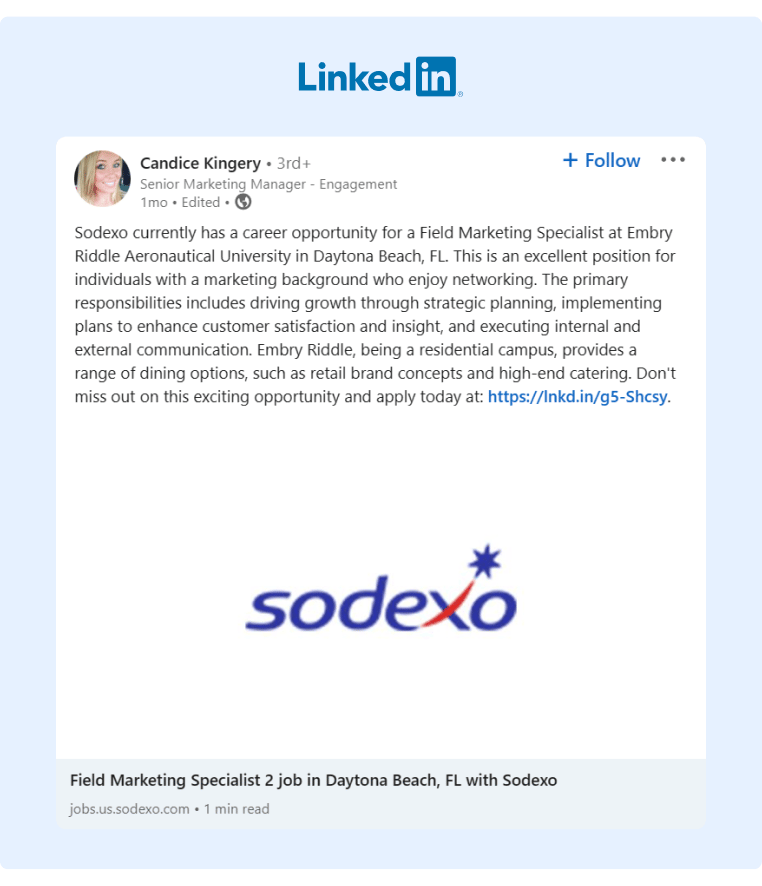
Source: Candice Kingery
The post not only includes the description of the position, but also why it would be a good fit for marketers, plus company perks. Now individuals in Candice’s network are aware of the job opening and can apply, or they can share it with their networks. This post just potentially increased Sodexo’s hiring reach. That’s the power of employee advocacy.
With employee advocacy, social media posts are typically published by the brand or executives, but employees can also create their own posts that promote brand messages. However, most brands don’t implement an employee advocacy strategy because it can be difficult to maintain employee engagement with the program. Employees tend to disengage because they’re not sure what to post, don’t know how to engage, or simply don’t have the time. Fortunately, you can avoid these problems by using an employee advocacy tool like GaggleAMP.
Using an Employee Advocacy Tool
GaggleAMP makes it easy for your brand to provide personalized engagement at scale.
With GaggleAMP, you can curate content for marketing teams, assign engagement activities with specific instructions to your employees, manage campaigns and schedule posts, and review analytics to see how your brand reach and engagement is performing on your social channels.
2. Affiliate Marketing
Affiliate marketing is a performance-based marketing strategy where individuals or businesses earn commission by promoting others’ products or services. When a customer clicks on that unique affiliate link, it takes them to a virtual storefront to make a purchase. Once the customer makes the purchase, the affiliate gets paid a monetary commission (rates will vary depending on the company and offer).
Scrolling through Facebook or Instagram, you’ve probably seen a celebrity or influencer include a discount code in their caption. In this example below, if you use the code KALEE20, you’ll save 20% off your purchase.

Source: Kalee Rose Beauty
That is affiliate marketing in action, and it’s a great way to get exposure (and sales) for your brand.
2. Email Marketing
Email marketing is a powerful tool that brands use to generate sales by sharing promotional offers, nurturing leads, and expanding the impact of content marketing efforts (e.g., sharing a blog post). Brands typically get you to opt-in to their email lists by asking for your email address during the checkout process.
Now that’s traditional email marketing. So, how does email marketing work with social media? Let’s say you share a piece of thought leadership on LinkedIn. By inserting a CTA within the LinkedIn article to join the company newsletter, you’ve just given the reader access to join your email list.
You can also pin a CTA post in LinkedIn groups, too, making it easy for members to sign up like Social Media Today does here:

Source: Social Media Today
Producing newsletters is also a form of content marketing, which brings us to our fourth strategy…
4. Content Marketing
Content marketing’s purpose is to create and distribute relevant content for target audiences to increase their interest in your brand. Content can take the form of blogs, emails, videos, social media posts, infographics, case studies, and e-books.
Here, Hilton uses an eye-catching nine second video clip to promote its first hotel located in Times Square. It also includes a CTA where you can click for more information.

Source: Hilton
On social media platforms, you’ll see brands share a variety of content that’s tailored for both the platform and the target audience (e.g., longform content doesn’t work on Twitter).
Remember to focus on creating and sharing content that resonates with your target audience.
Final Thoughts
For a brand to be successful, it needs to have a social media marketing strategy. Depending on the brand, social media marketing strategies will vary regarding goals, but the core strategy components will remain the same.
If you’re ready to launch your social media marketing strategy, consider implementing an employee advocacy program, too. To see how GaggleAMP can help, schedule your free demo today!










